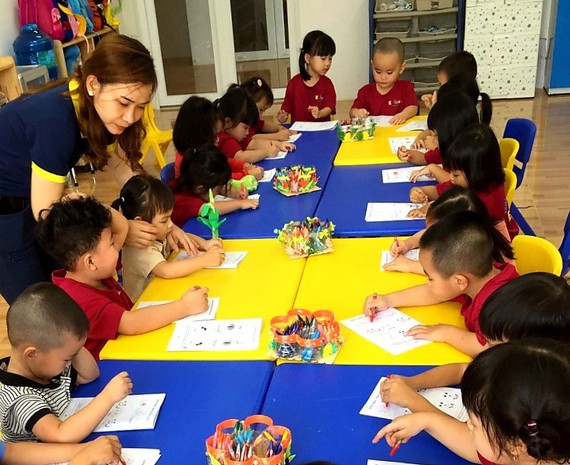 Society
Society


|
| Students attend a lesson at a non-public school in Sóc Trăng City. Photo courtesy of sggp.org.vn |
HCM CITY — Authorities of provinces have mobilised more social resources and invested in education development in the Cửu Long (Mekong Delta) region and have received positive results.
However, even though the number of non-public schools is increasing in number, size and quality, the region needs more preferential policies to attract more investment in education.
Cần Thơ City has about 562 educational institutions with nearly 376,000 students at all levels. As many as 110 of these are non-public institutions, accounting for 19.6 per cent of the city’s total educational establishments with 67,789 students, or 18.03 per cent of the city’s total students.
As a centre of the Cửu Long delta, Cần Thơ City has the highest proportion of non-public schools operating in the region, higher than the national average.
In addition to Cần Thơ, Sóc Trăng City has witnessed significant growth in the non-public preschool-level area.
The city has 13 schools, three educational establishments, and 17 groups and classes, all at preschool level that are non-public. They are responsible for 62.8 per cent of children going to school in Sóc Trăng City.
According to the secretary and chairman of the People’s Committee of Sóc Trăng City, Nguyễn Văn Quận, the city has always tried to create favourable conditions for investors to mobilise resources for education.
“Sóc Trăng has achieved initial success, especially at the preschool level. This has helped bring preschool education to more 5-year-old children and reduce the pressure on the public education system,” he said.
The Cửu Long delta region has long been considered a "low-lying area of education”, with budget expenditures for preschool and general education lower than that of the national average.
The network of schools and classes at all educational levels is also smaller than that of the rest of the country.
According to the Ministry of Education and Training, the region needs 3,300 new classrooms, upgrading of 8,550 existing classrooms, and 2,191 new sets of teaching equipment in order for ensuring education quality to reach the national average.
Considering the limited resources, provincial authorities believe that private funding is necessary to lift the region up from a “low-lying area”.
However, compared to other socio-economic sectors, education is not “attractive” to investors.
The managing director of the Pacific Education System in Cần Thơ, Nguyễn Thanh Thống, said that the need for quality education in the region are obvious, but a lack of attractive preferential policies has not inspired investors.
He added that the Pacific Education System for schools has been going on for 13 years, but admitted that enthusiasm is not enough to boost the sector.
Transparent and detailed policies would be a great motivator for investors to join the market, he said.
The legal framework on education investment attraction has been completed, but some investors are concerned that it is too difficult for them to access the preferential land fund for education development, and to take advantage of preferential credit capital for educational investment projects.
The vice chairman of the Edison Kindergarten System in Sóc Trăng City, Nguyễn Anh, said that investors need both preferential policies and specific mechanisms for the development of education in the Cửu Long Delta region. — VNS




